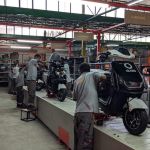The Emergence of InfraTech: How AI and Other Digital Technologies are Enabling Climate-Resilient Transportation Infrastructure in LMICs
There are an estimated 1 billion people in the world who lack access to all-weather roads. This means that, despite billions of dollars invested over the years in developing transportation infrastructure in low- and middle-income countries (LMICs), over 12% of the world’s population — roughly the equivalent of both the United States and Europe’s population combined — lacks the reliable ability to travel to school or work throughout the year. This is particularly detrimental to the agriculture sector in regions like Africa, where a lack of reliable infrastructure prevents farmers from getting produce to market, resulting in post-harvest losses that claim as much as 37% of perishable food.
In today’s world of AI and other advanced digital technologies, it’s easy to forget how critical physical infrastructure is to our lives. Regardless of the latest AI tools or digital widget, without roads, bridges or physical transportation networks, it would be impossible to live our daily lives. However, accessibility to basic transportation infrastructure remains a major challenge in LMICs, particularly in the face of changing climate and weather patterns. There is a need for a more comprehensive approach to developing climate-resilient transportation infrastructure in these countries. Such an approach needs to leverage the latest in advanced technologies, while also taking into consideration environmental and social factors, such as the participation of local communities in the process.
Advanced digital technologies like AI can play a significant role in the physical world of infrastructure, especially in LMICs. These tools can be particularly transformative in remote and inaccessible areas, where harsh climates and poor infrastructure can be uniquely damaging to people’s livelihoods and economic activities. But applying these technologies requires both a first-hand understanding of some of the challenges in these regions, and sophisticated knowledge of the latest technologies — and how they can be adapted and leveraged to address these challenges.
In this article, I’ll discuss several digital technologies that are optimizing transportation infrastructure in LMICs, exploring how this “InfraTech” is building climate resilience and supporting economic growth in these markets.
Generating Data where it’s Needed Most
In the world of financial inclusion, the essential role of data is widely recognized. There are many examples of fintech companies using advanced technology to acquire the data necessary to build digital records, enabling the “unbanked” to gain access to finance. However, few people realize the similarly transformative role data plays in the world of transportation infrastructure — particularly in LMICs, where this infrastructure is often either lacking or in dire need of repair.
In these contexts, accurate records of construction design, material/land usage, rainfall or elevation levels, or maintenance practices are often lacking. This significantly limits local authorities’ ability to build, maintain or repair critical infrastructure. Climate-resilient engineering practices require detailed data for optimizing design, building durable infrastructure, and using appropriate materials to withstand often harsh and changing climate conditions. This is relevant for every stage of transportation infrastructure development, from designing and building new climate-resilient roads and infrastructure, to maintaining or repairing existing roads within often limited budgets.
InfraTech can play a key role in this process. As defined by the World Bank-run Global Infrastructure Hub, the term is shorthand for “infrastructure technology,” and it involves “digital and non-digital technologies that, when applied at some point in the infrastructure lifecycle, enable step-change improvements in economic, social or environmental outcomes.” I’ll share several examples of how InfraTech is being applied in developing countries below.
Optimizing Social, Environmental and Economic Impact through AI and Satellite-Enabled Design
Before the process of building new road infrastructure even begins, advanced satellite technology can be used to determine where roads or highways should be built from the outset. For example, Earth Observation is a process of collecting, analyzing and presenting data about the Earth’s surface using remote sensing technologies, typically satellites, aircraft and/or drones. The data is processed and analyzed to generate different types of information, often referred to as layers, that can be used to monitor and/or assess ground features. Information obtained from Earth Observation sources can be modelled to provide further insights into the natural and built environment.
In the context of transportation infrastructure, this makes previously complex data collection much easier. For example, a traditional feasibility study for building a new highway used to require people on the ground, manually collecting data and taking measurements — a process that lasted many months. However, today much of this can be completed almost entirely remotely, within a few weeks, by leveraging Earth Observation, AI and machine learning to design the best routes for new roads.
These technologies help expert engineers to optimize the route design, reducing the completed roads’ exposure to climate events (e.g., landslides, flooding), minimizing the risk of death or injury (e.g., by suggesting alternative routes that avoid dangerous conditions), and maximizing the economic and social impact (e.g., by minimizing the need to relocate large populations, while routing roads as close as possible to population centers to increase their access).
Innovative Maintenance Technologies enabling Climate Adaptation and Resilience
Poorly maintained infrastructure sometimes feels like a way of life in LMICs, where potholes persist even in the middle of busy urban areas, and bumpy, unkept rural roads often seem inevitable. With limited budgets, fixing some of these challenges sometimes feels like an expendable priority. However, if communities fail to deal with these seemingly small challenges, a road in fair condition can quickly deteriorate, increasing the cost of rehabilitation considerably. According to the World Bank, providing good maintenance can reduce the life-cycle cost of transport and other essential infrastructure by over 50%.
Here too digital tools can play a key role. For example, mobile apps that use simple phone cameras or GoPro cameras mounted to a car can utilize solid-state or light sensors to collect data on road conditions without having to close a single road. This is a game-changer in the congested cities that are common in developing nations, were road closures for collecting data can cause significant disruptions, even at night. These devices can even be fitted to garbage trucks or other vehicles that are already driving the roads, gathering data while reducing costs and avoiding the need for any further carbon emissions.
Data collected from these innovative tools is then shared with transportation authorities through easily accessible dashboards that enable them to gain a full picture of their transportation infrastructure. Detailed AI-based analysis of this data (which was previously either unavailable or buried in paper-based, error-prone systems) enables these authorities to prioritize maintenance and repair work where it can have the most impact, even within limited budgets.
Further, once issues are identified, advanced technologies can be utilized to improve the long-term resilience of existing roads. For example, drones or LiDAR (remote sensing that works similarly to radar, but uses light from a laser) can be used to zoom into the relevant section of the road and create detailed engineering designs even in hard-to-reach areas. By generating detailed data about the state of the infrastructure, the materials used, and the surrounding topography, catchment areas and drainage elements, repairs can be optimized to climate-proof them against future disruptions.
Fit-For-Purpose Solutions for LMICs’ Infrastructure Challenges
These are just a few examples of the broad range of digital and AI-enabled technologies that are available for solving some of the many infrastructure challenges that are particularly acute in LMICs. AnyWay Solutions, a global engineering consulting firm where I lead corporate growth, leverages many of these advanced digital technologies, combining them with over 25 years of experience in providing climate-resilient solutions for transportation infrastructure in developing nations.
AnyWay has identified a range of appropriate InfraTech solutions that are well suited for addressing the unique challenges of transportation infrastructure in these markets. This often involves finding what our head of engineering Alex Campbell refers to as “fit-for-purpose” solutions.
This term refers to the identification of appropriate technologies that are affordable, easy-to-use, and adaptable to the local needs and on-the-ground reality of each environment. For example, a device that can be used when there is limited connectivity would be considered fit-for-purpose in remote areas, whereas a solution that collects an enormous amount of data would not be considered fit-for-purpose in an area that doesn’t have the capacity to store, analyze and/or interpret such data. Simply put, it’s all about choosing the solution that best fits the needs and capabilities of the community and environment a project is serving.
Providing this sort of solution requires a deep knowledge of the available technologies and an understanding of the local context and constraints. AnyWay has implemented many such solutions across multiple continents, and we are always open to sharing our knowledge of how to build and maintain climate-resilient infrastructure across emerging markets.
To learn more, contact me at ctalpert@anywaysolutions.com, or follow AnyWay Solutions on LinkedIn.
Caylee Talpert leads corporate growth at AnyWay Solutions.
Photo credit: Selcuk Bulbul
- Categories
- Technology, Transportation



